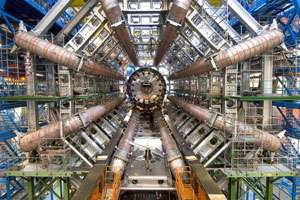Hints of unknown elementary particle explained using Swedish theory

Particle physicists around the world are currently on the edge of their seats awaiting information about the traces of a brand new particle that were found during the latest run of the Large Hadron Collider particle accelerator at CERN. One of these physicists is Christoffer Petersson at Chalmers University of Technology. In an article recently published in the journal, Physical Review Letters, he explains how he predicted the particle traces back in 2013.
"The discovery of a new particle now would be the greatest discovery of the past 40 years. Much, much more momentous than the discovery of the Higgs particle, which was expected and didn't include any surprises," says Christoffer Petersson, researcher in Subatomic and Plasma Physics at Chalmers University of Technology in Sweden.
It was through particle collisions at CERN that the Higgs boson (particle) was discovered in 2012. It had been predicted for more than 40 years and completed what is known as the Standard Model. This model has up till now served as a map of all elementary particles in the universe, but has been unable to tell us, for example, what dark matter is. The CERN accelerator was restarted in 2015, following upgrades to boost the collision energy by 60 percent. The higher energy aimed to make it possible to create and see heavier particles that have no given place in the Standard Model. And the traces of precisely such a particle were presented on 15 December 2015.
"Following the Higgs discovery we remained none the wiser about how to proceed. However, a new particle would give us key clues as to which path we should take to find a new theory that can replace the Standard Model. This could mean several generations of work for both theorists and experimentalists, which is why many people are extremely enthusiastic and excited right now," says Christoffer Petersson.
More data need to be analysed for the traces of the new particle to be classed as confirmed. But the hope that such confirmation could be given towards the end of the summer was strengthened when new findings from the CERN accelerator were presented in March 2016 that showed the traces even more clearly. That's when it also became clear to Christoffer Petersson and his colleague, Riccardo Torre, at École Polytechnique Fédérale de Lausanne in Switzerland, that the findings tallied exactly with the theoretical predictions that they had published back in 2013.
"We heard rumours that they had found more collisions than expected that produced two photons, or light particles. As this tallied exactly with our theory we immediately wrote an article based on that theory. The fact that these traces matched our previously proposed theory makes our explanation well justified. There are, of course, a great many other possible explanations, but the vast majority of them are ex post theories subsequently presented," says Christoffer Petersson.
What has been found repeatedly are two photons with total energy that becomes mass corresponding to six times the mass of the Higgs particle. This could be because a new, heavy particle has been created in the collisions and has then disintegrated into two photons. The theory put forward by Christoffer Petersson and Riccardo Torre is based on supersymmetry, which suggests a possible extension of the Standard Model by saying that each particle in it has a much heavier superpartner. This means that for all known elementary particles there are a further equal number yet to be discovered.
Researchers have sought alternatives to the Standard Model for 40 years. The possibility of obtaining experimental results that can be used to either reinforce or reject many of the proposed theories now looks more promising than ever. Although Christoffer Petersson's article recently garnered attention in several scientific journals, he thinks that the most exciting thing is to be present at a revolutionary time.
"Now, the first dream is that this trace will be confirmed. It would be like starting again right from the beginning. Simply being able to be active at a time during which the entire field is entering into a new era would be totally fantastic."
More information: Christoffer Petersson et al. 750 GeV Diphoton Excess from the Goldstino Superpartner, Physical Review Letters (2016). DOI: 10.1103/PhysRevLett.116.151804
Won Sang Cho et al. 750 GeV Diphoton Excess May Not Imply a 750 GeV Resonance, Physical Review Letters (2016). DOI: 10.1103/PhysRevLett.116.151805
Davide Castelvecchi. Zoo of theories showcased in publications on LHC anomaly, Nature (2016). DOI: 10.1038/nature.2016.19757
Journal information: Physical Review Letters , Nature
Provided by Chalmers University of Technology




















